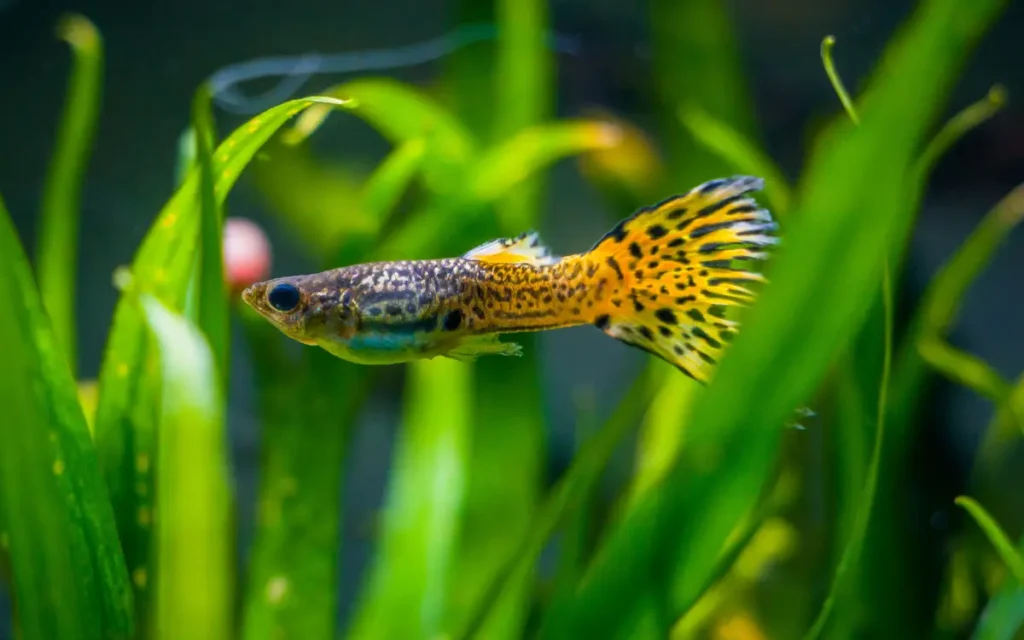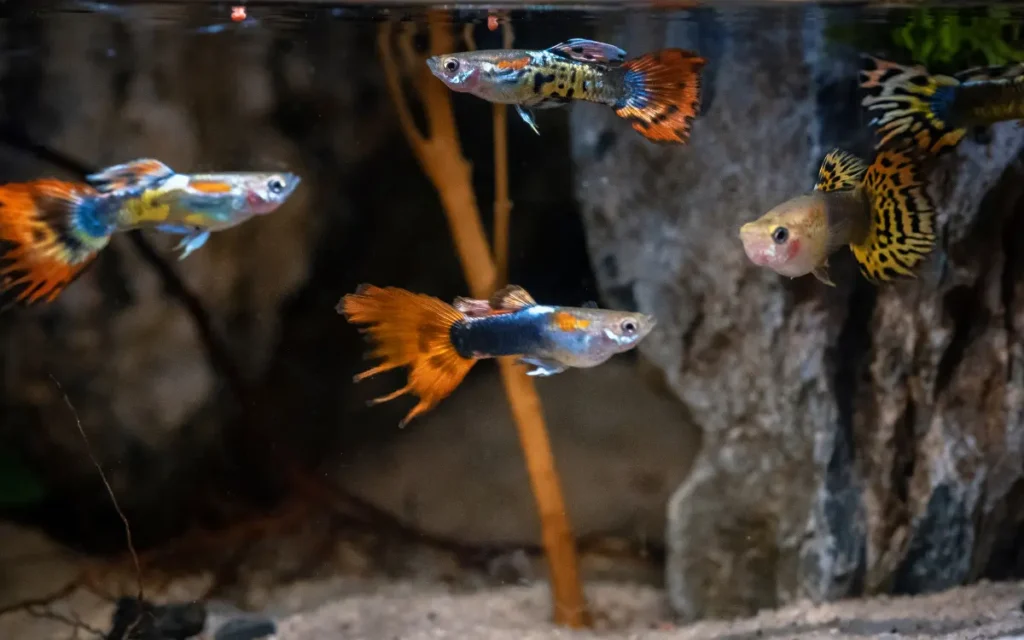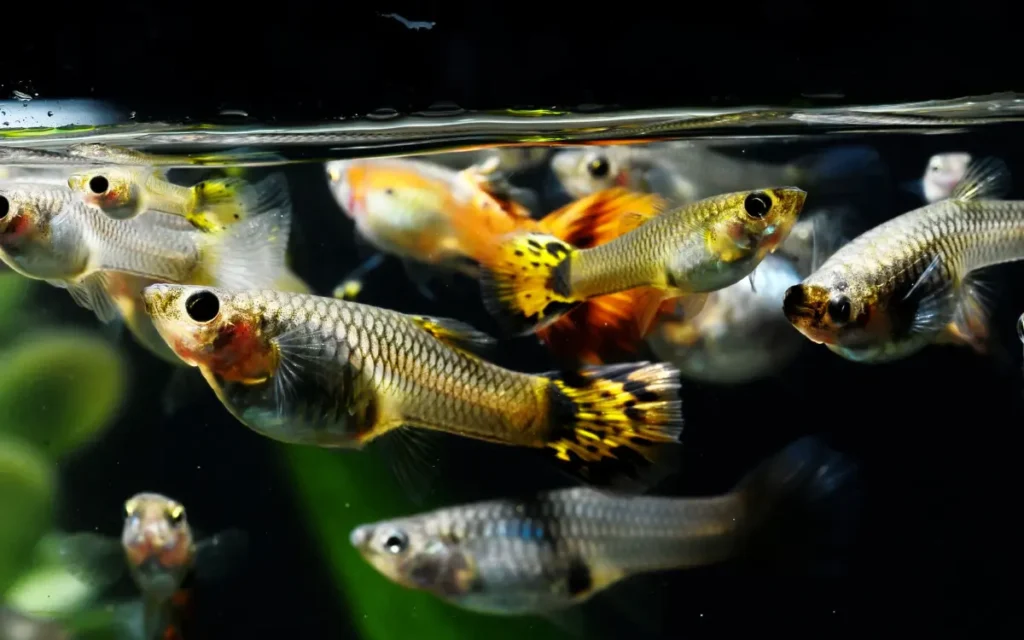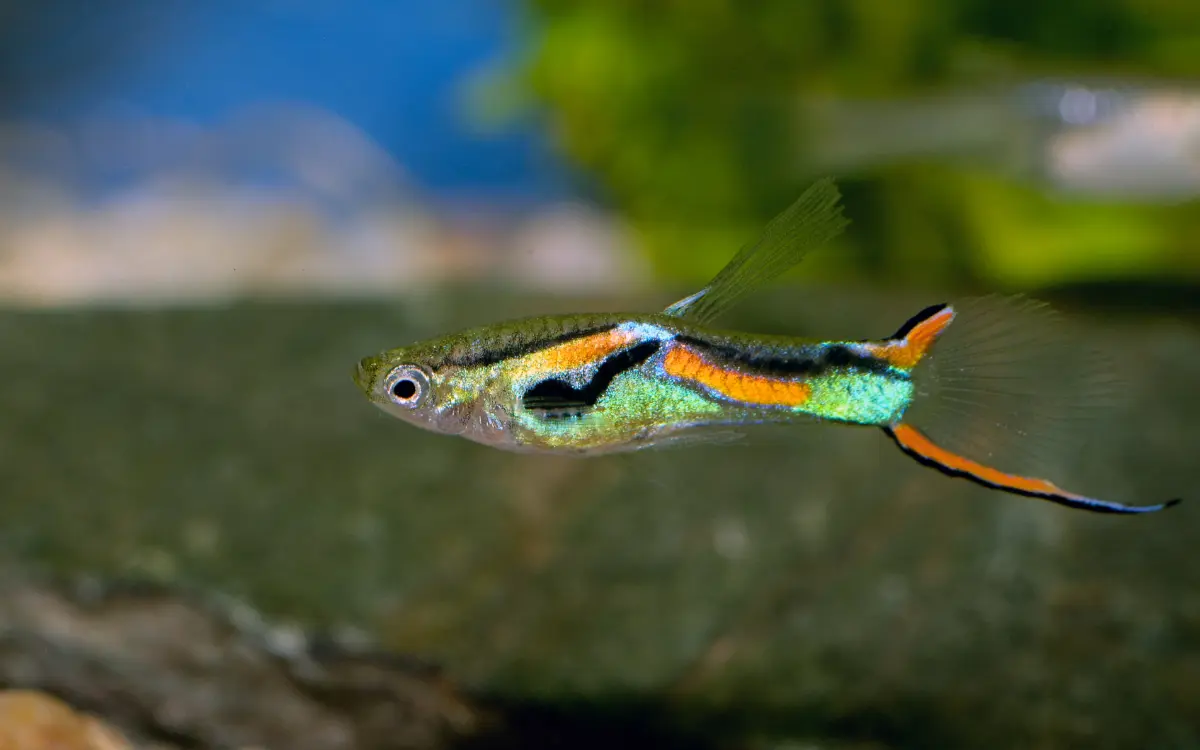Do you want to keep guppies in your aquariums or want to know more about this little fish .
They are a very peaceful and popular choice for freshwater aquariums.
Easy to care for and great for beginners, guppies add beauty and activity to any tank.
We’ll explore everything you need to know about guppies, from their care requirements to the benefits they bring to your aquarium.

Guppy Fish Profile
| Category | Details |
| Family | Poeciliidae |
| Aggressiveness | Peaceful |
| Minimum Tank Size | 10 gallons |
| Life Span | 2-3 years |
| Diet | Omnivorous (flakes, pellets, live food) |
| Size | 1.5-2.5 inches |
| Compatibility | Good with other peaceful fish (tetras, mollies, etc.) |
| Temperament | Active, social, and peaceful |
Natural Habitat

Where Guppies Come From
Guppies originate from the freshwater rivers and streams of South America, particularly in countries like Venezuela, Brazil, and Guyana.
They also found different types of places worldwide.
Guppy Natural Environment and Behavior
In the wild, guppies inhabit shallow, warm waters with plenty of vegetation.
This environment provides them with ample hiding spots from predators and a rich source of food.
Guppies are omnivorous, feeding on algae, plant matter, and small invertebrates. They are social and active swimmers, often seen darting around in groups.
In an aquarium setting, replicating their natural habitat with plants and clean, warm water helps them thrive and display their best colors and behaviors.
Selecting Your Guppy Fish
What to Look for in a Healthy Guppy
- Clear eyes
- No visible signs of disease
- Active swimming
- Vibrant color
- Intact fins
Choosing the Right Guppy
Male vs. Female Guppies: Males are more colorful, females are larger and less colorful.
Colors and Patterns: Choose based on personal preference; there are many varieties.
Best Guppy Fish Tank for Beginners
Tank Size
- 20-Gallon Tank: Ideal for beginners; provides ample space for guppies to swim and helps maintain stable water conditions.
Tank Setup
- Filtration: A good quality filter to keep the water clean and provide oxygen.
- Heater: Maintain a stable temperature around 75-82°F.
- Lighting: Moderate lighting to support plant growth and display fish colors.
- Substrate: Fine gravel or sand; easy to clean and safe for guppies.
Decorations and Plants
- Live Plants: Java moss, Anubias, and Amazon swords provide hiding spots and improve water quality.
- Hiding Spots: Rocks, caves, and decorations for shelter and security.
Maintenance
- Regular Water Changes: 20-30% weekly to keep water parameters stable.
- Water Testing: Regularly test for pH, ammonia, nitrites, and nitrates.
Compatibility
- Tank Mates: Other peaceful fish like tetras, mollies, and corydoras are good companions for guppies.
Related article:-Aquarium Sizes and Shapes: Choosing the Right Tank for Your Needs
Maintaining Guppy Fish Health
Common Diseases
- Fin Rot: Frayed, discolored fins.
- Treatment: Isolate affected fish, improve water quality, use antibacterial medication.
- Ich (White Spot Disease): White spots on body and fins.
- Treatment: Raise water temperature gradually, use ich medication.
- Parasites: Scratching against objects, visible worms or spots.
- Treatment: Use antiparasitic medication, improve water conditions.
Preventative Care
- Regular Tank Maintenance: Weekly water changes (20-30%), clean filter regularly.
- Proper Water Conditions and Parameters: Maintain stable temperature (75-82°F), pH around 7.0, test water regularly for ammonia, nitrites, and nitrates.
Signs of a Healthy vs. Unhealthy Guppy
Behavioral Indicators:
- Healthy: Active, eating well, social.
- Unhealthy: Lethargic, loss of appetite, hiding.
Physical Signs:
- Healthy: Bright colors, clear eyes, intact fins.
- Unhealthy: Dull colors, cloudy eyes, frayed or clamped fins.
Feeding Guppy Fish
| Feeding Guppy Fish | Details |
| Types of Food | Flakes, pellets, live food (brine shrimp, daphnia), frozen food |
| Best Guppy Fish Food | High-quality flakes and pellets, live foods (for treats), and frozen foods |
| How Much to Feed Guppies | Only as much as they can eat in 2-3 minutes per feeding session |
| Feeding Schedule | 2-3 times a day |
| Can Guppies Eat Human Food? | Yes, but sparingly. Suitable options include finely chopped vegetables (spinach, peas), and small amounts of cooked egg yolk |
| Special Considerations | |
| – Feeding on Vacation | Use an automatic feeder or vacation feeder blocks. Ask someone to feed them if possible. |
| – Overfeeding Consequences | Can lead to poor water quality, health issues such as bloating and swim bladder problems. Remove uneaten food to prevent this. |
Breeding Guppy Fish

Preparation
Choosing Breeding Pairs: Select healthy, vibrant guppies with desirable traits. Aim for one male per two to three females to reduce stress.
Setting Up a Breeding Tank: Use a separate tank with plenty of plants for hiding. Maintain optimal water conditions (75-82°F, pH around 7.0).
Breeding Process
Guppy Fish Mating Behavior: Males display their fins and chase females. Females give birth to live fry after about 4 weeks.
Caring for Guppy Fry: Transfer pregnant females to the breeding tank. Once fry are born, remove adults to prevent them from eating the fry. Feed fry with finely crushed flakes or special fry food.
Challenges and Tips
Common Breeding Issues: Overcrowding, poor water quality, and predation by adult fish.
Tip: Keep the breeding tank clean and monitor water conditions closely.
Raising Guppy Fry: Provide plenty of hiding spots and ensure a varied diet for proper growth. Perform regular water changes to maintain a healthy environment.
FAQs
Are guppy fish easy to care for?
Yes, guppy fish are easy to care for and are ideal for beginners. They require basic maintenance, such as regular water changes and feeding, and they adapt well to a range of water conditions.
How many guppies should be kept together?
It’s best to keep guppies in groups of at least 5-6. They are social fish and thrive better when they have companions.
Do guppies need direct sunlight?
No, guppies do not need direct sunlight. In fact, direct sunlight can cause algae growth and temperature fluctuations. Aquarium lights are sufficient for their needs.
Do guppies need an air pump?
While guppies can survive without an air pump, it is recommended to have one to ensure adequate oxygenation in the tank, especially in densely populated tanks.
Is a guppy a lucky fish?
In some cultures, guppies are considered lucky due to their vibrant colors and active nature, which are believed to bring positive energy.
Can guppies live in drinking water?
Guppies need water that is free from chlorine and other harmful chemicals found in untreated tap water. Always use a water conditioner or dechlorinated water.
What is the size of guppy Poecilia reticulata?
Guppies, or Poecilia reticulata, typically grow to be 1.5-2.5 inches in length.
Are guppies aggressive?
Guppies are generally peaceful and are not aggressive. They do well in community tanks with other non-aggressive fish.
Do guppies eat mosquitoes?
Yes, guppies are known to eat mosquito larvae, making them useful for controlling mosquito populations in ponds and other bodies of

